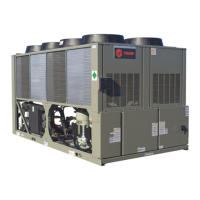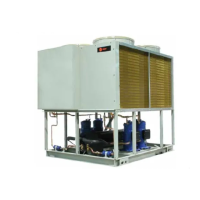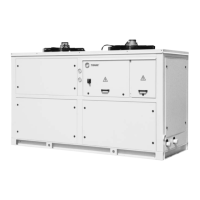168 CG-SVX17D-EN
Diagnostics
Explanatory Comments
Diagnostic Text:
Black text is intended for use on TechView. It has no intrinsic length limit. It should contain few or
no abbreviations.
Blue (italicized) text is intended for use on DynaView. It has a 40 character length limit for
English and other European languages, based on 8 pixel character width (DynaView’s display
is 320 pixels wide). The text should be abbreviated as necessary to meet the length limit.
Trane standard abbreviations or ASME standard abbreviations (ASME Y14.38-1999 or later)
should be used wherever possible.
Orange (underlined) text is intended for use on LCI-C. LCI-C has a 28 character length
limit for English and other European languages, based on one character per byte (LCI-
C diagnostic text has a 28 byte limit). It should be abbreviated as necessary to meet
the length limit. Trane standard abbreviations or ASME standard abbreviations
(ASME Y14.38-1999 or later) should be used wherever possible. “Comm:” is the
standard abbreviation for “Comm Loss:” in order to leave enough space for the rest of
the diagnostic text.
Legacy Hex Code: Three digit hexadecimal code used on all past products to uniquely identify
diagnostics.
Diagnostic Name and Source: Name of Diagnostic and its source. Note that this is the exact text
used in the User Interface and/or Service Tool displays.
The following codes were added to cover the unmapped diagnostics:
• 6B6: Unknown Chiller Diagnostic
• 6B7: Unknown Compressor Diagnostic
Affects Target: Defines the “target” or what is affected by the diagnostic. Usually either the entire
Chiller, or a particular component is affected by the diagnostic (the same one as the source), but
in special cases functions are modified or disabled by the diagnostic. None implies that there is
no direct affect to the chiller, sub components or functional operation.
Severity: Defines the severity of the above effect. Immediate means immediate shutdown of the
effected portion, Normal means normal or friendly shutdown of the effected portion, Special
Mode means a special mode of operation (limp along) is invoked, but without shutdown, and
Warning means an Informational Note or Warning is generated.
Persistence: Defines whether or not the diagnostic and its effects are to be manually reset
(Latched), or can be either manually or automatically reset (Nonlatched).
Active Modes [Inactive Modes]: States the modes or periods of operation that the diagnostic
is active in and, as necessary, those modes or periods that it is specifically not active in as an
exception to the active modes. The inactive modes are enclosed in brackets, [ ]. Note that the modes
used in this column are internal and not generally annunciated to any of the formal mode displays
Criteria: Quantitatively defines the criteria used in generating the diagnostic and, if nonlatching,
the criteria for auto reset. If more explanation is necessary a hot link to the Functional Specification
is used.
Reset Level: Defines the lowest level of manual diagnostic reset command which can clear the
diagnostic. The manual diagnostic reset levels in order of priority are: Local and Remote. A
diagnostic that has a reset level of Local, can only be reset by a local diagnostic reset command,
but not by the lower priority remote Reset command whereas a diagnostic listed as Remote reset
can be reset by either.

